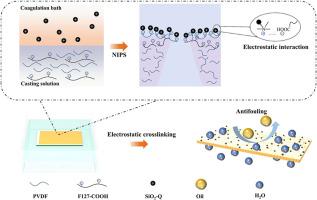Construction of nanocomposite coating on PVDF membrane via in-situ electrostatic crosslinking toward oil-water separation
IF 9
1区 工程技术
Q1 ENGINEERING, CHEMICAL
引用次数: 0
Abstract
Surface modification of membranes with inorganic nanomaterials presents an effective approach to fabricating antifouling oil-water separation membranes. In this study, we develops an in-situ electrostatic crosslinking method to fabricate oil-water separation membranes with nanocomposite coatings. The carboxyl-grafted F127(F127–COOH) is dissolved in the casting solution, while the quaternary ammonium group-modified SiO2 nanoparticles (SiO2-Q) are dispersed in the coagulation bath. During the NIPS, F127–COOH anchors SiO2-Q on the membrane surface through in-situ electrostatic crosslinking, leading to the construction of a hydrophilic nanocomposite coating. The optimal membrane exhibits a permeance of up to 775 L m−2 h−1 bar−1, a flux decline rate as low as 4.7 %, and a flux recovery rate as high as 99.1 %, showing excellent antifouling performance. In addition, the prepared membrane exhibits outstanding self-cleaning property against high-viscosity crude oil. This work presents a facile method for membrane surface modification using functionalized nanomaterials.

原位静电交联在PVDF膜上构建油水分离纳米复合涂层
无机纳米材料对膜进行表面改性是制备防污油水分离膜的有效途径。在这项研究中,我们开发了一种原位静电交联方法来制备具有纳米复合涂层的油水分离膜。羧基接枝的F127(F127 - cooh)溶解在浇铸液中,季铵基修饰的SiO2纳米颗粒(SiO2- q)分散在混凝液中。在NIPS过程中,F127-COOH通过原位静电交联将SiO2-Q锚定在膜表面,从而构建亲水性纳米复合涂层。最佳膜的渗透率可达775 L m−2 h−1 bar−1,通量下降率低至4.7%,通量回收率高达99.1%,具有优异的防污性能。此外,制备的膜对高粘度原油具有良好的自清洁性能。本文提出了一种利用功能化纳米材料进行膜表面改性的简便方法。
本文章由计算机程序翻译,如有差异,请以英文原文为准。
求助全文
约1分钟内获得全文
求助全文
来源期刊

Journal of Membrane Science
工程技术-高分子科学
CiteScore
17.10
自引率
17.90%
发文量
1031
审稿时长
2.5 months
期刊介绍:
The Journal of Membrane Science is a publication that focuses on membrane systems and is aimed at academic and industrial chemists, chemical engineers, materials scientists, and membranologists. It publishes original research and reviews on various aspects of membrane transport, membrane formation/structure, fouling, module/process design, and processes/applications. The journal primarily focuses on the structure, function, and performance of non-biological membranes but also includes papers that relate to biological membranes. The Journal of Membrane Science publishes Full Text Papers, State-of-the-Art Reviews, Letters to the Editor, and Perspectives.
 求助内容:
求助内容: 应助结果提醒方式:
应助结果提醒方式:


